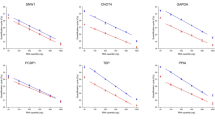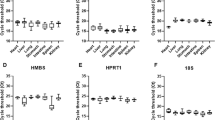Abstract
The study of the mammalian intestinal epithelium concerns several aspects of cellular and molecular biology. In fact, most of these studies aim to define molecular components or mechanisms related with the control of stemness and the balance between cell proliferation and differentiation in physiopathological conditions. It is worth mentioning that real-time quantitative reverse transcription-polymerase chain reaction (RT-qPCR) approaches are commonly used, but only a few studies are available regarding suitable reference genes to normalize gene expression data. The present study was designed to validate potential reference genes in freshly isolated proliferating or differentiated epithelial cells from the mouse intestine. We also extended our analysis to the IEC6 intestinal epithelial cells, as a promising model to study intestinal physiopathology in vitro. The stability of six potential reference genes (Hprt1, Ppia, Gapdh, Rplp0, Ppib, and Vil1) has been tested both in epithelial cells isolated from the mouse intestine and in the IEC6 cell line. The software programs—geNorm and Normfinder—were used to obtain an estimation of the expression stability of each gene and, by comparing the results, to identify the most suitable genes for RT-qPCR data normalization. These multiple approaches allowed us to select different suitable reference genes for the correct quantification of mRNAs depending on the differentiated or proliferative nature of the cells.






Similar content being viewed by others
References
Stappenbeck, T. S., Wong, M. H., Saam, J. R., Mysorekar, I. U., & Gordon, J. I. (1998). Notes from some crypt watchers: Regulation of renewal in the mouse intestinal epithelium. Current Opinion in Cell Biology, 10(6), 702–709.
Huang, E. H., & Wicha, M. S. (2008). Colon cancer stem cells: Implications for prevention and therapy. Trends in Molecular Medicine, 14(11), 503–509.
Stadtfeld, M., Maherali, N., Borkent, M., & Hochedlinger, K. (2010). A reprogrammable mouse strain from gene-targeted embryonic stem cells. Nature Methods, 7(1), 53–55.
Yu, J., Vodyanik, M. A., Smuga-Otto, K., Antosiewicz-Bourget, J., Frane, J. L., Tian, S., et al. (2007). Induced pluripotent stem cell lines derived from human somatic cells. Science, 318(5858), 1917–1920.
Wu, W. K., Cho, C. H., Lee, C. W., Fan, D., Wu, K., Yu, J., et al. (2010). Dysregulation of cellular signaling in gastric cancer. Cancer Letters, 295(2), 144–153.
Dheda, K., Huggett, J. F., Chang, J. S., Kim, L. U., Bustin, S. A., Johnson, M. A., et al. (2005). The implications of using an inappropriate reference gene for real-time reverse transcription PCR data normalization. Analytical Biochemistry, 344(1), 141–143.
Bustin, S. A. (2010). Why the need for qPCR publication guidelines?–The case for MIQE. Methods, 50(4), 217–226.
Huggett, J., Dheda, K., Bustin, S., & Zumla, A. (2005). Real-time RT-PCR normalisation; strategies and considerations. Genes and Immunity, 6(4), 279–284.
Bustin, S. A., Beaulieu, J. F., Huggett, J., Jaggi, R., Kibenge, F. S., Olsvik, P. A., et al. (2010). MIQE precis: Practical implementation of minimum standard guidelines for fluorescence-based quantitative real-time PCR experiments. BMC Molecular Biology, 11, 74.
Vandesompele, J., De Preter, K., Pattyn, F., Poppe, B., Van Roy, N., De Paepe, A., et al. (2002). Accurate normalization of real-time quantitative RT-PCR data by geometric averaging of multiple internal control genes. Genome Biology, 3(7), RESEARCH0034.
Andersen, C. L., Jensen, J. L., & Orntoft, T. F. (2004). Normalization of real-time quantitative reverse transcription-PCR data: a model-based variance estimation approach to identify genes suited for normalization, applied to bladder and colon cancer data sets. Cancer Research, 64(15), 5245–5250.
Quaroni, A., & Beaulieu, J. F. (1997). Cell dynamics and differentiation of conditionally immortalized human intestinal epithelial cells. Gastroenterology, 113(4), 1198–1213.
Quaroni, A., & May, R. J. (1980). Establishment and characterizaton of intestinal epithelial cell cultures. Methods in Cell Biology, 21B, 403–427.
Green, R. P., Cohn, S. M., Sacchettini, J. C., Jackson, K. E., & Gordon, J. I. (1992). The mouse intestinal fatty acid binding protein gene: nucleotide sequence, pattern of developmental and regional expression, and proposed structure of its protein product. DNA and Cell Biology, 11(1), 31–41.
Levy, E., Menard, D., Delvin, E., Montoudis, A., Beaulieu, J. F., Mailhot, G., et al. (2009). Localization, function and regulation of the two intestinal fatty acid-binding protein types. Histochemistry and Cell Biology, 132(3), 351–367.
Dydensborg, A. B., Herring, E., Auclair, J., Tremblay, E., & Beaulieu, J. F. (2006). Normalizing genes for quantitative RT-PCR in differentiating human intestinal epithelial cells and adenocarcinomas of the colon. American Journal of Physiology. Gastrointestinal and Liver Physiology, 290(5), G1067–G1074.
Wang, F., Wang, J., Liu, D., & Su, Y. (2010). Normalizing genes for real-time polymerase chain reaction in epithelial and nonepithelial cells of mouse small intestine. Analytical Biochemistry, 399(2), 211–217.
Strube, C., Buschbaum, S., Wolken, S., & Schnieder, T. (2008). Evaluation of reference genes for quantitative real-time PCR to investigate protein disulfide isomerase transcription pattern in the bovine lungworm Dictyocaulus viviparus. Gene, 425(1–2), 36–43.
Van Hiel, M. B., Van Wielendaele, P., Temmerman, L., Van Soest, S., Vuerinckx, K., Huybrechts, R., et al. (2009). Identification and validation of housekeeping genes in brains of the desert locust Schistocerca gregaria under different developmental conditions. BMC Molecular Biology, 10, 56.
Drago, S., El Asmar, R., Di Pierro, M., Grazia Clemente, M., Tripathi, A., Sapone, A., et al. (2006). Gliadin, zonulin and gut permeability: Effects on celiac and non-celiac intestinal mucosa and intestinal cell lines. Scandinavian Journal of Gastroenterology, 41(4), 408–419.
Trompette, A., Blanchard, C., Zoghbi, S., Bara, J., Claustre, J., Jourdan, G., et al. (2004). The DHE cell line as a model for studying rat gastro-intestinal mucin expression: Effects of dexamethasone. European Journal of Cell Biology, 83(7), 347–358.
Bavaria, M. N., Ray, R. M., & Johnson, L. R. (2011). The phosphorylation state of MRLC is polyamine dependent in intestinal epithelial cells. American Journal of Physiology. Cell Physiology, 300(1), C164–C175.
Balakrishnan, A., Stearns, A. T., Park, P. J., Dreyfuss, J. M., Ashley, S. W., Rhoads, D. B., et al. (2010). MicroRNA mir-16 is anti-proliferative in enterocytes and exhibits diurnal rhythmicity in intestinal crypts. Experimental Cell Research, 316(20), 3512–3521.
Samuels, H. H., Stanley, F., & Casanova, J. (1979). Depletion of l-3,5,3′-triiodothyronine and l-thyroxine in euthyroid calf serum for use in cell culture studies of the action of thyroid hormone. Endocrinology, 105(1), 80–85.
Weiser, M. M. (1973). Intestinal epithelial cell surface membrane glycoprotein synthesis. I. An indicator of cellular differentiation. Journal of Biological Chemistry, 248(7), 2536–2541.
Kress, E., Rezza, A., Nadjar, J., Samarut, J., & Plateroti, M. (2009). The frizzled-related sFRP2 gene is a target of thyroid hormone receptor alpha1 and activates beta-catenin signaling in mouse intestine. Journal of Biological Chemistry, 284(2), 1234–1241.
Resuehr, D., & Spiess, A. N. (2003). A real-time polymerase chain reaction-based evaluation of cDNA synthesis priming methods. Analytical Biochemistry, 322(2), 287–291.
Rozen, S., & Skaletsky, H. (2000). Primer3 on the WWW for general users and for biologist programmers. Methods in Molecular Biology, 132, 365–386.
Fu, L. Y., Jia, H. L., Dong, Q. Z., Wu, J. C., Zhao, Y., Zhou, H. J., et al. (2009). Suitable reference genes for real-time PCR in human HBV-related hepatocellular carcinoma with different clinical prognoses. BMC Cancer, 9, 49.
Shen, Y., Li, Y., Ye, F., Wang, F., Lu, W., & Xie, X. (2010). Identification of suitable reference genes for measurement of gene expression in human cervical tissues. Analytical Biochemistry, 405(2), 224–229.
Baba, T., Kobayashi, H., Kawasaki, H., Mineki, R., Naito, H., & Ohmori, D. (2010). Glyceraldehyde-3-phosphate dehydrogenase interacts with phosphorylated Akt resulting from increased blood glucose in rat cardiac muscle. FEBS Letters, 584(13), 2796–2800.
Wang, G. P., & Xu, C. S. (2010). Reference gene selection for real-time RT-PCR in eight kinds of rat regenerating hepatic cells. Molecular Biotechnology, 46(1), 49–57.
Akamine, R., Yamamoto, T., Watanabe, M., Yamazaki, N., Kataoka, M., Ishikawa, M., et al. (2007). Usefulness of the 5′ region of the cDNA encoding acidic ribosomal phosphoprotein P0 conserved among rats, mice, and humans as a standard probe for gene expression analysis in different tissues and animal species. Journal of Biochemical and Biophysical Methods, 70(3), 481–486.
Laborda, J. (1991). 36B4 cDNA used as an estradiol-independent mRNA control is the cDNA for human acidic ribosomal phosphoprotein PO. Nucleic Acids Research, 19(14), 3998.
Iwai, N., & Inagami, T. (1990). Molecular cloning of a complementary DNA to rat cyclophilin-like protein mRNA. Kidney International, 37(6), 1460–1465.
Arber, S., Krause, K. H., & Caroni, P. (1992). s-cyclophilin is retained intracellularly via a unique COOH-terminal sequence and colocalizes with the calcium storage protein calreticulin. Journal of Cell Biology, 116(1), 113–125.
Kainer, D. B., & Doris, P. A. (2000). Cyclophilin B expression in renal proximal tubules of hypertensive rats. Hypertension, 35(4), 958–964.
Rycyzyn, M. A., Reilly, S. C., O’Malley, K., & Clevenger, C. V. (2000). Role of cyclophilin B in prolactin signal transduction and nuclear retrotranslocation. Molecular Endocrinology, 14(8), 1175–1186.
Pinto, D., Robine, S., Jaisser, F., El Marjou, F. E., & Louvard, D. (1999). Regulatory sequences of the mouse villin gene that efficiently drive transgenic expression in immature and differentiated epithelial cells of small and large intestines. Journal of Biological Chemistry, 274(10), 6476–6482.
Robine, S., Huet, C., Moll, R., Sahuquillo-Merino, C., Coudrier, E., Zweibaum, A., et al. (1985). Can villin be used to identify malignant and undifferentiated normal digestive epithelial cells? Proceedings of the National Academy of Sciences of the United States of America, 82(24), 8488–8492.
Sirakov, M., Zarrella, I., Borra, M., Rizzo, F., Biffali, E., Arnone, M. I., et al. (2009). Selection and validation of a set of reliable reference genes for quantitative RT-PCR studies in the brain of the cephalopod mollusc Octopus vulgaris. BMC Molecular Biology, 10, 70.
Pfaffl, M. W., Tichopad, A., Prgomet, C., & Neuvians, T. P. (2004). Determination of stable housekeeping genes, differentially regulated target genes and sample integrity: BestKeeper–excel-based tool using pair-wise correlations. Biotechnology Letters, 26(6), 509–515.
Acknowledgments
The authors are grateful to Nadine Aguilera for help in animal handling. This study was supported by the Institut National pour le Cancer (grant INCA-2009-175), and the Ligue contre le Cancer Department du Rhone. FMC is supported by IARC and ARC.
Author information
Authors and Affiliations
Corresponding author
Additional information
Maria Sirakov and Marco Borra contributed equally to this study.
Rights and permissions
About this article
Cite this article
Sirakov, M., Borra, M., Cambuli, F.M. et al. Defining Suitable Reference Genes for RT-qPCR Analysis on Intestinal Epithelial Cells. Mol Biotechnol 54, 930–938 (2013). https://doi.org/10.1007/s12033-012-9643-3
Published:
Issue Date:
DOI: https://doi.org/10.1007/s12033-012-9643-3




